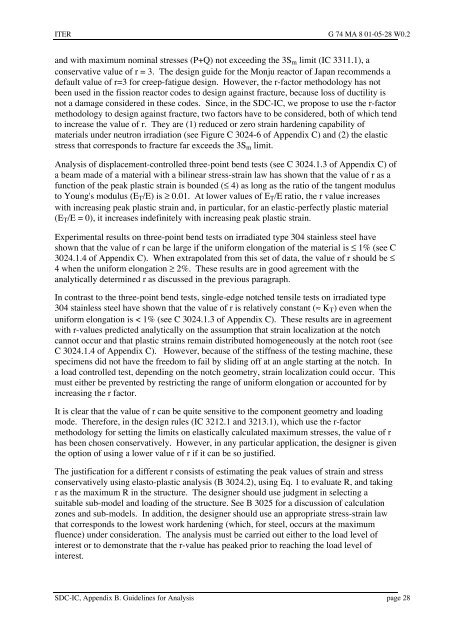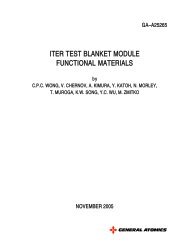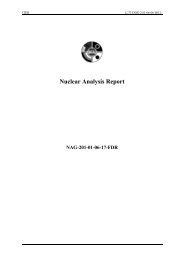iter structural design criteria for in-vessel components (sdc-ic)
iter structural design criteria for in-vessel components (sdc-ic)
iter structural design criteria for in-vessel components (sdc-ic)
You also want an ePaper? Increase the reach of your titles
YUMPU automatically turns print PDFs into web optimized ePapers that Google loves.
ITER G 74 MA 8 01-05-28 W0.2<br />
and with maximum nom<strong>in</strong>al stresses (P+Q) not exceed<strong>in</strong>g the 3Sm limit (IC 3311.1), a<br />
conservative value of r = 3. The <strong>design</strong> guide <strong>for</strong> the Monju reactor of Japan recommends a<br />
default value of r=3 <strong>for</strong> creep-fatigue <strong>design</strong>. However, the r-factor methodology has not<br />
been used <strong>in</strong> the fission reactor codes to <strong>design</strong> aga<strong>in</strong>st fracture, because loss of ductility is<br />
not a damage considered <strong>in</strong> these codes. S<strong>in</strong>ce, <strong>in</strong> the SDC-IC, we propose to use the r-factor<br />
methodology to <strong>design</strong> aga<strong>in</strong>st fracture, two factors have to be considered, both of wh<strong>ic</strong>h tend<br />
to <strong>in</strong>crease the value of r. They are (1) reduced or zero stra<strong>in</strong> harden<strong>in</strong>g capability of<br />
materials under neutron irradiation (see Figure C 3024-6 of Appendix C) and (2) the elast<strong>ic</strong><br />
stress that corresponds to fracture far exceeds the 3Sm limit.<br />
Analysis of displacement-controlled three-po<strong>in</strong>t bend tests (see C 3024.1.3 of Appendix C) of<br />
a beam made of a material with a bil<strong>in</strong>ear stress-stra<strong>in</strong> law has shown that the value of r as a<br />
function of the peak plast<strong>ic</strong> stra<strong>in</strong> is bounded (£ 4) as long as the ratio of the tangent modulus<br />
to Young's modulus (ET/E) is ³ 0.01. At lower values of ET/E ratio, the r value <strong>in</strong>creases<br />
with <strong>in</strong>creas<strong>in</strong>g peak plast<strong>ic</strong> stra<strong>in</strong> and, <strong>in</strong> part<strong>ic</strong>ular, <strong>for</strong> an elast<strong>ic</strong>-perfectly plast<strong>ic</strong> material<br />
(ET/E = 0), it <strong>in</strong>creases <strong>in</strong>def<strong>in</strong>itely with <strong>in</strong>creas<strong>in</strong>g peak plast<strong>ic</strong> stra<strong>in</strong>.<br />
Experimental results on three-po<strong>in</strong>t bend tests on irradiated type 304 sta<strong>in</strong>less steel have<br />
shown that the value of r can be large if the uni<strong>for</strong>m elongation of the material is £ 1% (see C<br />
3024.1.4 of Appendix C). When extrapolated from this set of data, the value of r should be £<br />
4 when the uni<strong>for</strong>m elongation ³ 2%. These results are <strong>in</strong> good agreement with the<br />
analyt<strong>ic</strong>ally determ<strong>in</strong>ed r as discussed <strong>in</strong> the previous paragraph.<br />
In contrast to the three-po<strong>in</strong>t bend tests, s<strong>in</strong>gle-edge notched tensile tests on irradiated type<br />
304 sta<strong>in</strong>less steel have shown that the value of r is relatively constant (» KT) even when the<br />
uni<strong>for</strong>m elongation is < 1% (see C 3024.1.3 of Appendix C). These results are <strong>in</strong> agreement<br />
with r-values pred<strong>ic</strong>ted analyt<strong>ic</strong>ally on the assumption that stra<strong>in</strong> localization at the notch<br />
cannot occur and that plast<strong>ic</strong> stra<strong>in</strong>s rema<strong>in</strong> distributed homogeneously at the notch root (see<br />
C 3024.1.4 of Appendix C). However, because of the stiffness of the test<strong>in</strong>g mach<strong>in</strong>e, these<br />
specimens did not have the freedom to fail by slid<strong>in</strong>g off at an angle start<strong>in</strong>g at the notch. In<br />
a load controlled test, depend<strong>in</strong>g on the notch geometry, stra<strong>in</strong> localization could occur. This<br />
must either be prevented by restr<strong>ic</strong>t<strong>in</strong>g the range of uni<strong>for</strong>m elongation or accounted <strong>for</strong> by<br />
<strong>in</strong>creas<strong>in</strong>g the r factor.<br />
It is clear that the value of r can be quite sensitive to the component geometry and load<strong>in</strong>g<br />
mode. There<strong>for</strong>e, <strong>in</strong> the <strong>design</strong> rules (IC 3212.1 and 3213.1), wh<strong>ic</strong>h use the r-factor<br />
methodology <strong>for</strong> sett<strong>in</strong>g the limits on elast<strong>ic</strong>ally calculated maximum stresses, the value of r<br />
has been chosen conservatively. However, <strong>in</strong> any part<strong>ic</strong>ular appl<strong>ic</strong>ation, the <strong>design</strong>er is given<br />
the option of us<strong>in</strong>g a lower value of r if it can be so justified.<br />
The justif<strong>ic</strong>ation <strong>for</strong> a different r consists of estimat<strong>in</strong>g the peak values of stra<strong>in</strong> and stress<br />
conservatively us<strong>in</strong>g elasto-plast<strong>ic</strong> analysis (B 3024.2), us<strong>in</strong>g Eq. 1 to evaluate R, and tak<strong>in</strong>g<br />
r as the maximum R <strong>in</strong> the structure. The <strong>design</strong>er should use judgment <strong>in</strong> select<strong>in</strong>g a<br />
suitable sub-model and load<strong>in</strong>g of the structure. See BÊ3025 <strong>for</strong> a discussion of calculation<br />
zones and sub-models. In addition, the <strong>design</strong>er should use an appropriate stress-stra<strong>in</strong> law<br />
that corresponds to the lowest work harden<strong>in</strong>g (wh<strong>ic</strong>h, <strong>for</strong> steel, occurs at the maximum<br />
fluence) under consideration. The analysis must be carried out either to the load level of<br />
<strong>in</strong>terest or to demonstrate that the r-value has peaked prior to reach<strong>in</strong>g the load level of<br />
<strong>in</strong>terest.<br />
SDC-IC, Appendix B. Guidel<strong>in</strong>es <strong>for</strong> Analysis page 28




